

Chin J Plant Ecol ›› 2025, Vol. 49 ›› Issue (5): 697-709.DOI: 10.17521/cjpe.2023.0397 cstr: 32100.14.cjpe.2023.0397
Special Issue: 草原与草业
• Research Articles • Previous Articles Next Articles
HAN Fei1,2,3, WANG Ge1,2,3, WU Shuai-Kai1,2,3, LIN Mao1,2,3, DONG Kuan-Hu1,2,3, $\boxed{\hbox{WANG Chang-Hui}}$ 1,2,3,*, SU Yuan1,2,3,*( )
)
Received:2023-12-29
Accepted:2024-05-22
Online:2025-05-20
Published:2025-04-14
Contact:
$\boxed{\hbox{WANG Chang-Hui}}$ , SU Yuan
Supported by:HAN Fei, WANG Ge, WU Shuai-Kai, LIN Mao, DONG Kuan-Hu, $\boxed{\hbox{WANG Chang-Hui}}$ , SU Yuan. Effects of extreme precipitation on soil gross nitrification rate, gross nitrogen mineralization rate and sensitivity of different types of grassland[J]. Chin J Plant Ecol, 2025, 49(5): 697-709.
Add to citation manager EndNote|Ris|BibTeX
URL: https://www.plant-ecology.com/EN/10.17521/cjpe.2023.0397
| 草原类型 Grassland type | 草甸草原 Meadow steppe | 典型草原 Typical steppe | 荒漠草原 Desert steppe |
|---|---|---|---|
| 优势物种 Dominant species | 羊草、糙隐子草、 狼针草、扁蓄豆 Leymus chinensis, Cleistogenes squarrosa, Stipa baicalensis, Pocockia ruthenia | 赖草、碱茅、碱蒿 L. secalinus, Puccinellia distans, Artemisia anethifolia | 羊草、短花针茅、 点地梅、糙隐子草 L. chinensis, S. breviflora, Androsace umbellata, C. squarrosa |
| 土壤类型 Soil type | 黑钙土 Chernozems | 栗钙土 Kastanozems | 棕钙土、灰棕漠土 Brown calcic soils and grey-brown desert soils |
| 年平均气温 MAT (℃) | -2.4 | 4.6 | 4.5 |
| 年降水量 MAP (mm) | 400 | 425 | 180 |
| 土壤酸碱度 Soil pH | 6-7 | 9-10 | 7.5-9.5 |
| 总有机碳含量 TOC content (mg·g-1) | 48.1 | 43.6 | 10.7 |
| 全氮含量 TN content (mg·g-1) | 4.09 | 13.00 | 1.23 |
| 全磷含量 TP content (mg·g-1) | 0.64 | 0.78 | 0.33 |
| 可溶性有机氮含量 DON content (mg·kg-1) | 8.91 | 1.71 | 12.55 |
| 可溶性有机碳含量 DOC content (mg·kg-1) | 8.01 | 12.97 | 26.31 |
Table 1 Plant composition and soil physiochemical properties of different grassland types
| 草原类型 Grassland type | 草甸草原 Meadow steppe | 典型草原 Typical steppe | 荒漠草原 Desert steppe |
|---|---|---|---|
| 优势物种 Dominant species | 羊草、糙隐子草、 狼针草、扁蓄豆 Leymus chinensis, Cleistogenes squarrosa, Stipa baicalensis, Pocockia ruthenia | 赖草、碱茅、碱蒿 L. secalinus, Puccinellia distans, Artemisia anethifolia | 羊草、短花针茅、 点地梅、糙隐子草 L. chinensis, S. breviflora, Androsace umbellata, C. squarrosa |
| 土壤类型 Soil type | 黑钙土 Chernozems | 栗钙土 Kastanozems | 棕钙土、灰棕漠土 Brown calcic soils and grey-brown desert soils |
| 年平均气温 MAT (℃) | -2.4 | 4.6 | 4.5 |
| 年降水量 MAP (mm) | 400 | 425 | 180 |
| 土壤酸碱度 Soil pH | 6-7 | 9-10 | 7.5-9.5 |
| 总有机碳含量 TOC content (mg·g-1) | 48.1 | 43.6 | 10.7 |
| 全氮含量 TN content (mg·g-1) | 4.09 | 13.00 | 1.23 |
| 全磷含量 TP content (mg·g-1) | 0.64 | 0.78 | 0.33 |
| 可溶性有机氮含量 DON content (mg·kg-1) | 8.91 | 1.71 | 12.55 |
| 可溶性有机碳含量 DOC content (mg·kg-1) | 8.01 | 12.97 | 26.31 |

Fig. 1 Effect of precipitation change on soil temperature, soil water content, and inorganic nitrogen content in different grassland types. CK, control; CK+50%, increased precipitation by 50%; CK-50%, decreased precipitation by 50%. Different uppercase letters indicate significant differences in different grassland types under CK treatment (p < 0.05); ns, p > 0.05. *, significant differences among different precipitation treatments within the same grassland types (p < 0.05). D × G, the interaction of precipitation reduction and grassland types; In × G, the interaction of precipitation enhancement and grassland types. Box plots, average plots (—), display medians (50th percentile), 25th and 75th percentiles, and approximate 95% confidence intervals. Each dot represents a sample.
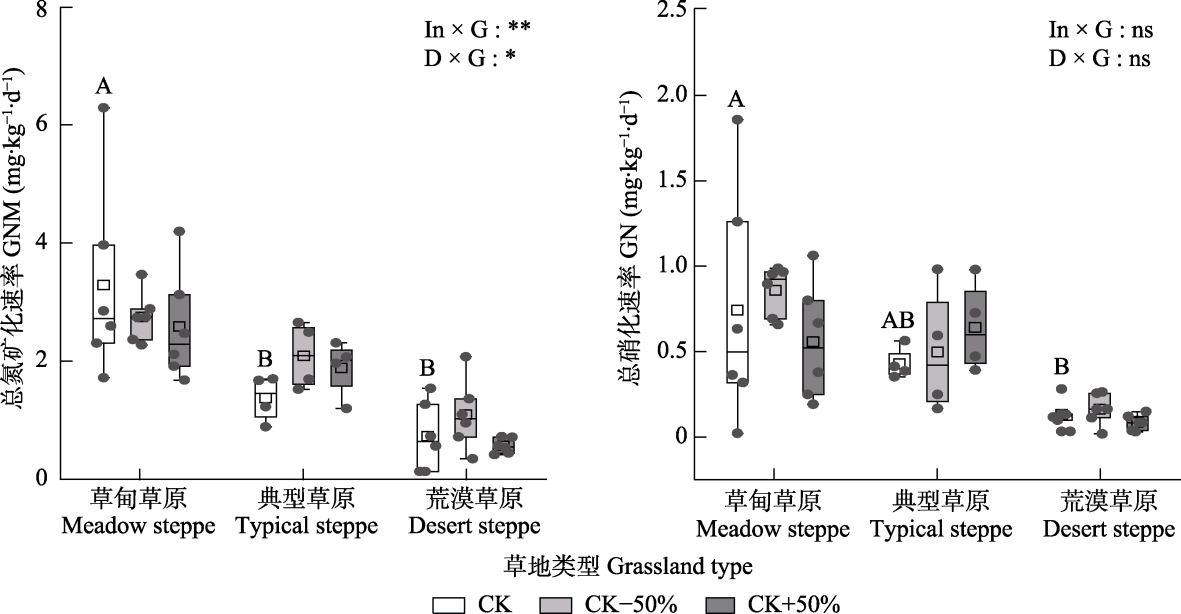
Fig. 2 Effect of precipitation change on soil gross nitrogen mineralization rate (GNM) and soil gross nitrification rate (GN) in different grassland types. CK, control; CK-50%, decreased precipitation by 50%; CK+50%, increased precipitation by 50%. Different uppercase letters indicate significant differences in different grassland types under CK treatment (p < 0.05); ns, p > 0.05. *, significant differences among different precipitation treatments within the same grassland types (p < 0.05). D × G, the interaction of precipitation reduction and grassland types; In × G, the interaction of precipitation enhancement and grassland types. Box plots, average plots (—), display medians (50th percentile), 25th and 75th percentiles, and approximate 95% confidence intervals. Each dot represents a sample.
| df | 土壤总氮矿化速率 GNM | 土壤总硝化速率 GN | |
|---|---|---|---|
| 固定效应 Fixed effect | |||
| 草原类型 Grassland type (G) | 3 | <0.001*** | <0.001*** |
| 改变降水 Change precipitation (P) | 3 | <0.001*** | <0.001*** |
| 草原类型×改变降水 G × P | 9 | <0.001*** | <0.001*** |
| 随机效应 Random effect | |||
| 土壤含水量 SWC | - | 0.034* | 0.459 |
| 土壤温度 ST | - | 0.999 | 0.928 |
| 铵态氮含量 NH4+-N content | - | <0.001*** | 0.997 |
| 硝态氮含量 NO-3-N content | - | <0.001*** | 0.952 |
| 土壤可溶性有机碳含量 DOC content | - | 1.000 | 0.681 |
| 土壤可溶性有机氮含量 DON content | - | 0.771 | <0.001*** |
| 微生物生物量碳含量 MBC content | - | 0.962 | 0.942 |
| 微生物生物量氮含量 MBN content | - | <0.001*** | 0.938 |
Table 2 Linear mixed model of the effect of soil factor on gross nitrogen mineralization (GNM) rate and gross nitrification (GN) rate of soil in different grassland types (p value)
| df | 土壤总氮矿化速率 GNM | 土壤总硝化速率 GN | |
|---|---|---|---|
| 固定效应 Fixed effect | |||
| 草原类型 Grassland type (G) | 3 | <0.001*** | <0.001*** |
| 改变降水 Change precipitation (P) | 3 | <0.001*** | <0.001*** |
| 草原类型×改变降水 G × P | 9 | <0.001*** | <0.001*** |
| 随机效应 Random effect | |||
| 土壤含水量 SWC | - | 0.034* | 0.459 |
| 土壤温度 ST | - | 0.999 | 0.928 |
| 铵态氮含量 NH4+-N content | - | <0.001*** | 0.997 |
| 硝态氮含量 NO-3-N content | - | <0.001*** | 0.952 |
| 土壤可溶性有机碳含量 DOC content | - | 1.000 | 0.681 |
| 土壤可溶性有机氮含量 DON content | - | 0.771 | <0.001*** |
| 微生物生物量碳含量 MBC content | - | 0.962 | 0.942 |
| 微生物生物量氮含量 MBN content | - | <0.001*** | 0.938 |
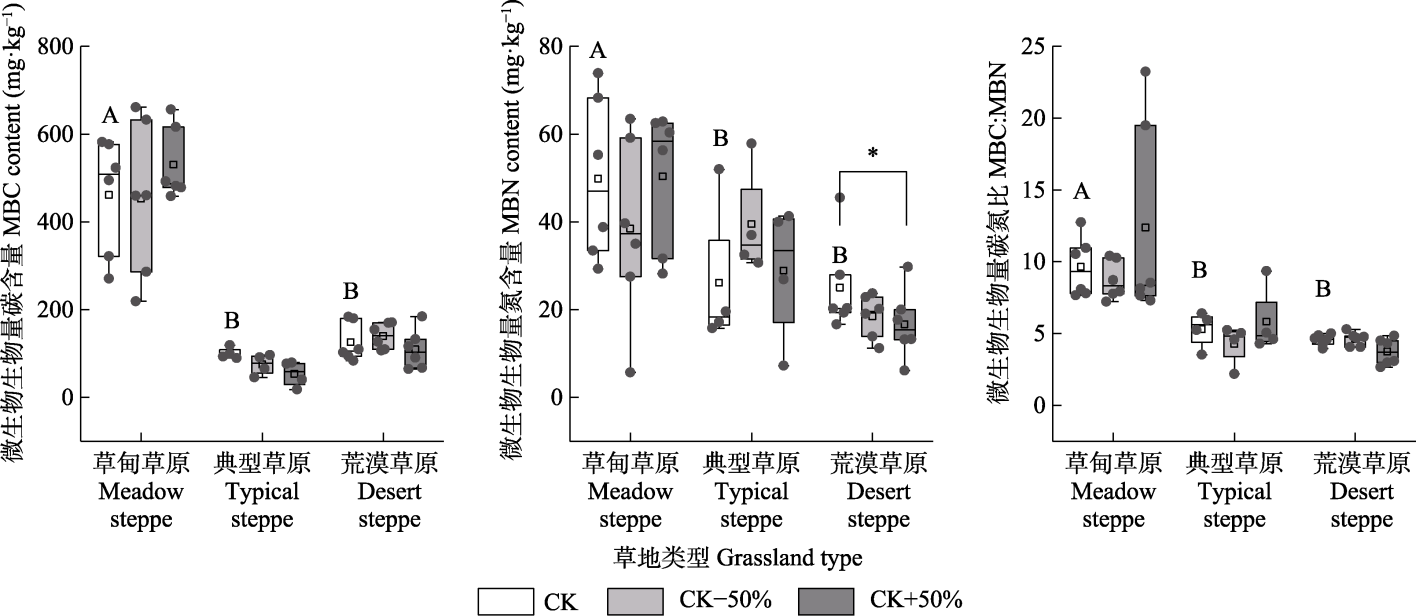
Fig. 3 Effect of precipitation change on soil microbial biomass in different grassland types. MBC, microbial biomass carbon; MBN, microbial biomass nitrogen. CK, control; CK-50%, decreased precipitation by 50%; CK+50%, increased precipitation by 50%. Different uppercase letters indicate significant differences in different grassland types under CK treatment (p < 0.05); *, significant differences among different precipitation treatments within the same grassland types (p < 0.05). Box plots, average plots (—), display medians (50th percentile), 25th and 75th percentiles, and approximate 95% confidence intervals. Each dot represents a sample.
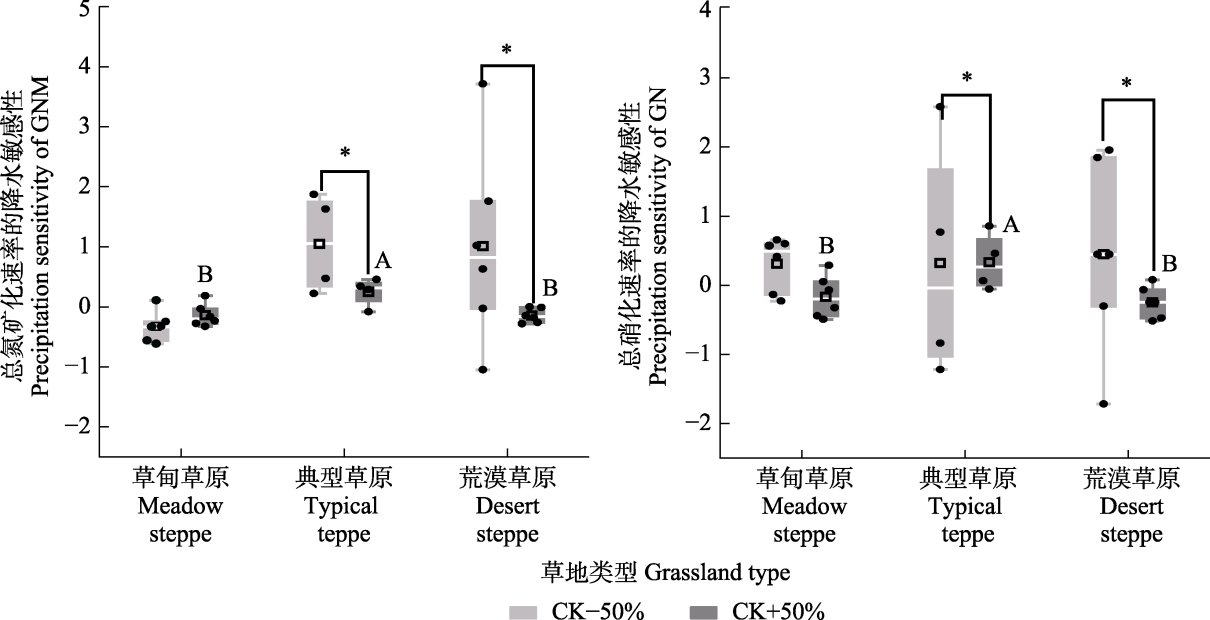
Fig. 4 Effect of precipitation change on the sensitivity of soil gross nitrogen mineralization rate (GNM) and soil gross nitrification rate (GN) in different grassland type. CK-50%, decreased precipitation by 50%; CK+50%, increased precipitation by 50%. Different uppercase letters indicate significant differences in different grassland types under CK+50% treatment (p < 0.05); ns, p > 0.05. *, significant differences among different precipitation treatments within the same grassland types (p < 0.05). D × G, the interaction of precipitation reduction and grassland types; In × G, the interaction of precipitation enhancement and grassland types. Box plots, average plots (—), display medians (50th percentile), 25th and 75th percentiles, and approximate 95% confidence intervals. Each dot represents a sample.
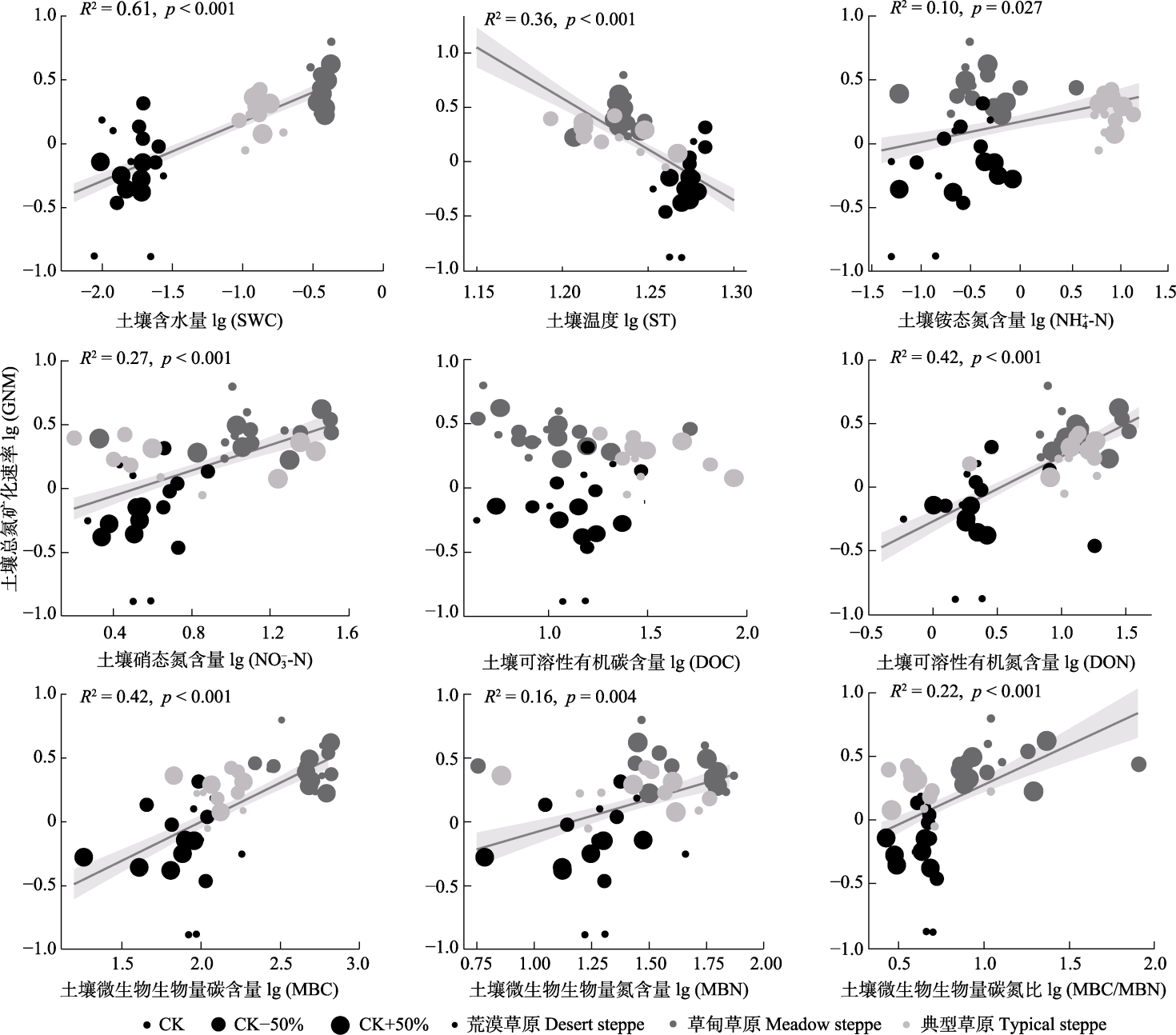
Fig. 5 Relationship between soil gross nitrogen mineralization rate (GNM) and soil physicochemical properties. CK, control; CK-50%, decreased precipitation by 50%; CK+50%, increased precipitation by 50%. DOC, dissolved organic carbon content; DON, dissolved organic nitrogen content; GNM, gross nitrogen mineralization rate; MBC, microbial biomass carbon content; MBN, microbial biomass nitrogen content; NH4+-N, ammonium nitrogen content; NO-3-N, nitrate nitrogen content; ST, soil temperature; SWC, soil water content.
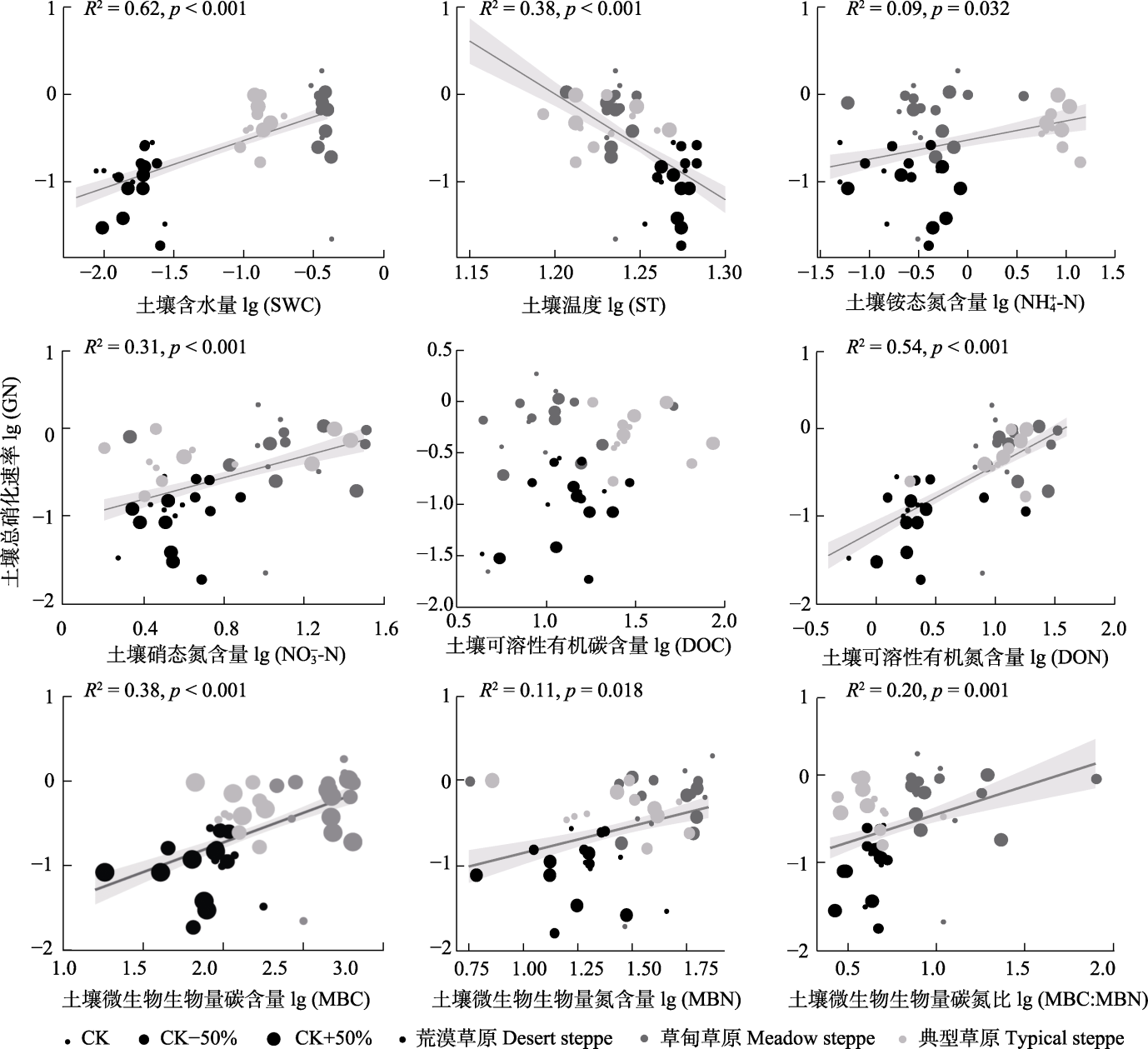
Fig. 6 Relationship between soil gross nitrification rate (GN) and soil physicochemical properties. CK, control; CK-50%, decreased precipitation by 50%; CK+50%, increased precipitation by 50%. DOC, dissolved organic carbon content; DON, dissolved organic nitrogen content; GN, global gross nitrification rate; MBC, microbial biomass carbon content; MBN, microbial biomass nitrogen content; NH4+-N, ammonium nitrogen content; NO-3-N, nitrate nitrogen content; ST, soil temperature; SWC, soil water content.
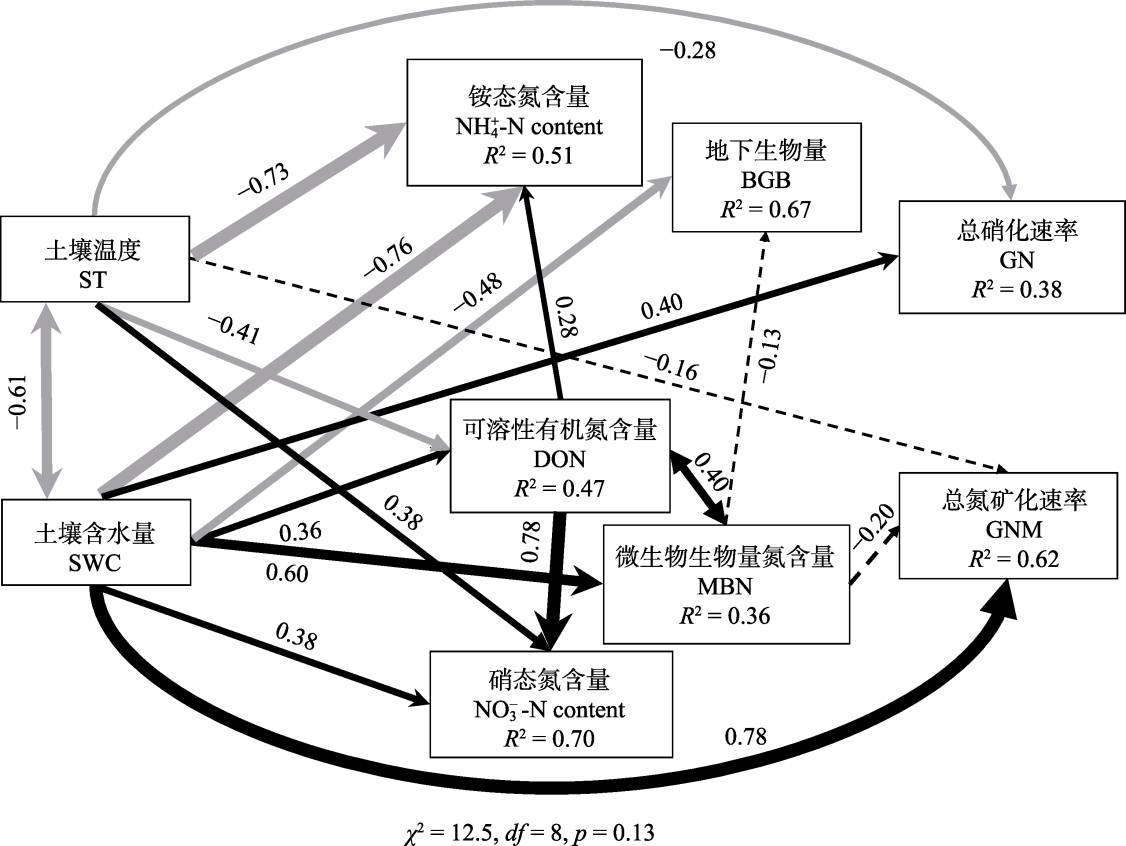
Fig. 7 Effect of soil physicochemical properties, below-ground biomass (BGB), and soil microbial biomass on soil gross nitrogen mineralization rate (GNM) in northern grasslands. Black and grey solid lines indicated positive and negative relationships, respectively. Black dotted lines indicate an insignificant relationship. The arrow width is proportional to the strength of the relationship. DOC, dissolved organic carbon content; DON, dissolved organic nitrogen content; GN, soil gross nitrification rate; MBN, microbial biomass nitrogen content; ST, soil temperature; SWC, soil water content.
| [1] | Brown VA (2021). An introduction to linear mixed-effects modeling in R. Advances in Methods and Practices in Psychological Science, 4, 2515245920960351. DOI: 10.1177/2515245920960351. |
| [2] | Chen H, Gurmesa GA, Zhang W, Zhu X, Zheng M, Mao Q, Zhang T, Mo J (2016). Nitrogen saturation in humid tropical forests after 6 years of nitrogen and phosphorus addition: hypothesis testing. Functional Ecology, 30, 305-313. |
| [3] | Chen L, Zeng J, Li H, Liu SL, Lei LQ, Liu SR (2020). Research advances in the soil nitrogen cycle under global precipitation pattern change. Acta Ecologica Sinica, 40, 7543-7551. |
| [ 陈琳, 曾冀, 李华, 刘士玲, 雷丽群, 刘世荣 (2020). 全球降水格局变化下土壤氮循环研究进展. 生态学报, 40, 7543-7551.] | |
| [4] | Cheng Y, Wang J, Mary B, Zhang JB, Cai ZC, Chang SX (2013). Soil pH has contrasting effects on gross and net nitrogen mineralizations in adjacent forest and grassland soils in central Alberta, Canada. Soil Biology & Biochemistry, 57, 848-857. |
| [5] | Dannenberg MP, Wise EK, Smith WK (2019). Reduced tree growth in the semiarid United States due to asymmetric responses to intensifying precipitation extremes. Science Advances, 5, eaaw0667. DOI: 10.1126/sciadv.aaw0667. |
| [6] | Diao HJ, Yang JQ, Hao J, Yan XD, Dong KH, Wang CH (2023). Seasonal precipitation regulates magnitude and direction of the effect of nitrogen addition on net ecosystem CO2 exchange in saline-alkaline grassland of northern China. Science of the Total Environment, 877, 162907. DOI: 10.1016/j.scitotenv.2023.162907. |
| [7] | Elrys AS, Abo El-Maati MF, Dan X, Wen Y, Mou J, Abdelghany AE, Uwiragiye Y, Tang S, Wu Y, Meng L, Zhang J, Müller C (2024). Aridity creates global thresholds in soil nitrogen retention and availability. Global Change Biology, 30, e17003. DOI: 10.1111/gcb.17003. |
| [8] |
Elrys AS, Ali A, Zhang H, Cheng Y, Zhang J, Cai ZC, Müller C, Chang SX (2021). Patterns and drivers of global gross nitrogen mineralization in soils. Global Change Biology, 27, 5950-5962.
DOI PMID |
| [9] | Feyissa A, Yang F, Wu J, Chen Q, Zhang D, Cheng X (2021). Soil nitrogen dynamics at a regional scale along a precipitation gradient in secondary grassland of China. Science of the Total Environment, 781, 146736. DOI: 10.1016/j.scitotenv.2021.146736. |
| [10] | Gao CY, Qi ZY, Zheng H, Chen XY, Qin JM, Hao J, Zhang NL, Wang CH, Dong KH (2022). Response of soil available nutrients and microbial characteristics to short-term grazing intensities. Acta Agrestia Sinica, 30, 1641-1650. |
|
[ 高昌宇, 齐志远, 郑慧, 陈玺洋, 秦加敏, 郝杰, 张乃莉, 王常慧, 董宽虎 (2022). 土壤有效养分和微生物特征对短期不同放牧强度的响应. 草地学报, 30, 1641-1650.]
DOI |
|
| [11] | Grimm NB, Chapin III FS, Bierwagen B, Gonzalez P, Groffman PM, Luo Y, Melton F, Nadelhoffer K, Pairis A, Raymond PA, Schimel J, Williamson CE (2013). The impacts of climate change on ecosystem structure and function. Frontiers in Ecology and the Environment, 11, 474-482. |
| [12] | Holguin J, Collins SL, McLaren JR (2022). Belowground responses to altered precipitation regimes in two semi-arid grasslands. Soil Biology & Biochemistry, 171, 108725. DOI: 10.1016/j.soilbio.2022.108725. |
| [13] | Hook PB, Burke IC (1995). Evaluation of methods for estimating net nitrogen mineralization in a semiarid grassland. Soil Science Society of America Journal, 59, 831-837. |
| [14] | The Intergovernmental Panel on Climate Change (IPCC) (2021). Climate Change 2021: The Physical Science Basis: Contribution of Working Group I to the Sixth Assessment Report of the Intergovernmental Panel on Climate Change. Cambridge University Press, Cambridge, UK. |
| [15] |
Keuper F, Dorrepaal E, van Bodegom PM, van Logtestijn R, Venhuizen G, van Hal J, Aerts R (2017). Experimentally increased nutrient availability at the permafrost thaw front selectively enhances biomass production of deep-rooting subarctic peatland species. Global Change Biology, 23, 4257-4266.
DOI PMID |
| [16] | Kirkham D, Bartholomew WV (1954). Equations for following nutrient transformations in soil, utilizing tracer data. Soil Science Society of America Journal, 18, 33-34. |
| [17] | Kou D, Peng Y, Wang G, Ding J, Chen Y, Yang G, Fang K, Liu L, Zhang B, Müller C, Zhang J, Yang Y (2018). Diverse responses of belowground internal nitrogen cycling to increasing aridity. Soil Biology & Biochemistry, 116, 189-192. |
| [18] | Larsen KS, Andresen LC, Beier C, Jonasson S, Albert KR, Ambus P, Arndal MF, Carter MS, Christensen S, Holmstrup M, Ibrom A, Kongstad J, van der Linden L, Maraldo K, Michelsen A, et al. (2011). Reduced N cycling in response to elevated CO2, warming, and drought in a Danish heathland: synthesizing results of the CLIMAITE project after two years of treatments. Global Change Biology, 17, 1884-1899. |
| [19] | Leyrer V, Patulla M, Hartung J, Marhan S, Poll C (2022). Long-term manipulation of mean climatic conditions alters drought effects on C- and N-cycling in an arable soil. Global Change Biology, 28, 3974-3990. |
| [20] | Li S, Chen YN, Wei W, Fang GH, Duan WL (2024). The increase in extreme precipitation and its proportion over global land. Journal of Hydrology, 628, 130456. DOI: 10.1016/j.jhydrol.2023.130456. |
| [21] | Maxwell TL, Canarini A, Bogdanovic I, Böckle T, Martin V, Noll L, Prommer J, Séneca J, Simon E, Piepho HP, Herndl M, Pötsch EM, Kaiser C, Richter A, Bahn M, Wanek W (2022). Contrasting drivers of belowground nitrogen cycling in a montane grassland exposed to a multifactorial global change experiment with elevated CO2, warming, and drought. Global Change Biology, 28, 2425-2441. |
| [22] | Mukherjee S, Aadhar S, Stone D, Mishra V (2018). Increase in extreme precipitation events under anthropogenic warming in India. Weather and Climate Extremes, 20, 45-53. |
| [23] | Niu S, Classen AT, Dukes JS, Kardol P, Liu L, Luo Y, Rustad L, Sun J, Tang J, Templer PH, Thomas RQ, Tian D, Vicca S, Wang YP, Xia J, Zaehle S (2016). Global patterns and substrate-based mechanisms of the terrestrial nitrogen cycle. Ecology Letters, 19, 697-709. |
| [24] | Peng YF, Zhao X, Wu DH, Tang BJ, Xu PP, Du XZ, Wang HY (2018). Spatiotemporal variability in extreme precipitation in China from observations and projections. Water, 10, 1089. DOI: 10.3390/w10081089. |
| [25] | Qiu Y, Jiang Y, Guo L, Zhang L, Burkey KO, Zobel RW, Reberg-Horton SC, Shew HD, Hu S (2019). Shifts in the composition and activities of denitrifiers dominate CO2 stimulation of N2O emissions. Environmental Science & Technology, 53, 11204-11213. |
| [26] | Shi Y, Wang J, Ao Y, Han J, Guo Z, Liu X, Zhang J, Mu C, Le Roux X (2021). Responses of soil N2O emissions and their abiotic and biotic drivers to altered rainfall regimes and co-occurring wet N deposition in a semi-arid grassland. Global Change Biology, 27, 4894-4908. |
| [27] |
Song L, Wang JS, Zhang RY, Pan JX, Li Y, Wang S, Niu SL (2023). Threshold responses of soil gross nitrogen transformation rates to aridity gradient. Global Change Biology, 29, 4018-4027.
DOI PMID |
| [28] |
Šťovíček A, Kim M, Or D, Gillor O (2017). Microbial community response to hydration-desiccation cycles in desert soil. Scientific Reports, 7, 45735. DOI: 10.1038/srep45735.
PMID |
| [29] | Sun JM, Liu W, Pan QM, Zhang B, Lv YX, Huang JH, Han XG (2022). Positive legacies of severe droughts in the Inner Mongolia grassland. Science Advances, 8, eadd6249. DOI: 10.1126/sciadv.add6249. |
| [30] |
Wang C, Chen Z, Unteregelsbacher S, Lu H, Gschwendtner S, Gasche R, Kolar A, Schloter M, Kiese R, Butterbach-Bahl K, Dannenmann M (2016). Climate change amplifies gross nitrogen turnover in montane grasslands of Central Europe in both summer and winter seasons. Global Change Biology, 22, 2963-2978.
DOI PMID |
| [31] | Wang CH, Wang NN, Zhu JX, Liu Y, Xu XF, Niu SL, Yu GR, Han XG, He NP (2018a). Soil gross N ammonification and nitrification from tropical to temperate forests in eastern China. Functional Ecology, 32, 83-94. |
| [32] | Wang N, Li L, Dannenmann M, Luo Y, Xu X, Zhang B, Chen S, Dong K, Huang J, Xu X, Wang C (2021). Seasonality of gross ammonification and nitrification altered by precipitation in a semi-arid grassland of Northern China. Soil Biology & Biochemistry, 154, 108146. DOI: 10.1016/j.soilbio.2021.108146. |
| [33] | Wang X, Yoo K, Wackett AA, Gutknecht J, Amundson R, Heimsath A (2018b). Soil organic carbon and mineral interactions on climatically different hillslopes. Geoderma, 322, 71-80. |
| [34] | Westra S, Fowler HJ, Evans JP, Alexander LV, Berg P, Johnson F, Kendon EJ, Lenderink G, Roberts NM (2014), Future changes to the intensity and frequency of short-duration extreme rainfall. Reviews of Geophysics, 52, 522-555. |
| [35] | Wu Q, Yue K, Ma Y, Heděnec P, Cai Y, Chen J, Zhang H, Shao J, Chang SX, Li Y (2022). Contrasting effects of altered precipitation regimes on soil nitrogen cycling at the global scale. Global Change Biology, 28, 6679-6695. |
| [36] | Xu C (2022). The Resistance and Resilience of Grassland Productivity to Extreme Drought. PhD dissertation, Lanzhou University, Lanzhou. 14-18. |
| [ 徐翀 (2022). 极端干旱背景下草原植被生产力的抵抗力和恢复力研究. 博士学位论文, 兰州大学, 兰州. 14-18.] | |
| [37] | Xu GR, Li G, Wu JQ, Ma WW, Wang HY, Yuan JY, Li XD (2023). Effects of rainfall amount and frequencies on soil net nitrogen mineralization in Gahai wet meadow in the Qinghai-Tibetan Plateau. Scientific Reports, 13, 14860. DOI: 10.1038/s41598-023-39267-3. |
| [38] | Xu XH, Diao HJ, Qin CY, Hao J, Shen Y, Dong KH, Wang CH (2021). Response of soil net nitrogen mineralization to different levels of nitrogen addition in a saline-alkaline grassland of northern China. Chinese Journal of Plant Ecology, 45, 85-95. |
| [ 徐小惠, 刁华杰, 覃楚仪, 郝杰, 申颜, 董宽虎, 王常慧 (2021). 华北盐渍化草地土壤净氮矿化速率对不同水平氮添加的响. 植物生态学报, 45, 85-95.] | |
| [39] | Yang WH, Ryals RA, Cusack DF, Silver WL (2017). Cross-biome assessment of gross soil nitrogen cycling in California ecosystems. Soil Biology & Biochemistry, 107, 144-155. |
| [40] | Zeng YL, Xiang WH, Deng XW, Fang X, Liu C, Peng CH (2014). Soil N forms and gross transformation rates in Chinese subtropical forests dominated by different tree species. Plant and Soil, 384, 231-242. |
| [41] | Zhang C, Lei S, Wu H, Liao L, Wang X, Zhang L, Song Z (2024). Simplified microbial network reduced microbial structure stability and soil functionality in alpine grassland along a natural aridity gradient. Soil Biology & Biochemistry, 191, 109366. DOI: 10.1038/s41598-023-39267-3. |
| [42] | Zhang J, Zhu T, Cai Z, Müller C (2011). Nitrogen cycling in forest soils across climate gradients in Eastern China. Plant and Soil, 342, 419-432. |
| [43] | Zhang JB, Wang L, Zhao W, Hu HF, Feng XJ, Müller C, Cai ZC (2016). Soil gross nitrogen transformations along the Northeast China Transect (NECT) and their response to simulated rainfall events. Scientific Reports, 6, 22830. DOI: 10.1038/srep22830. |
| [44] |
Zhang KC, Qiu YP, Zhao YF, Wang SH, Deng J, Chen MF, Xu XY, Wang H, Bai TS, He TQ, Zhang Y, Chen HH, Wang Y, Hu SJ (2023). Moderate precipitation reduction enhances nitrogen cycling and soil nitrous oxide emissions in a semi-arid grassland. Global Change Biology, 29, 3114-3129.
DOI PMID |
| [45] | Zhao FC, Chen HF, Wang YH, Dong KH, Wang CH, Chen XP (2022). Response of rhizosphere soil properties to changed precipitation and nitrogen addition in a salinized grassland. Acta Agrestia Sinica, 30, 2430-2437. |
|
[ 赵芳草, 陈鸿飞, 王一昊, 董宽虎, 王常慧, 陈晓鹏 (2022). 盐渍化草地根际土壤理化性质对降水改变和氮添加的响应. 草地学报, 30, 2430-2437.]
DOI |
|
| [46] | Zhao W, Zhang JB, Müller C, Cai ZC (2018). Effects of pH and mineralisation on nitrification in a subtropical acid forest soil. Soil Research, 56, 275-283. |
| [47] | Zhao YY, Ding Y, Hou XY, Li FY, Han WJ, Yun XJ (2017). Effects of temperature and grazing on soil organic carbon storage in grasslands along the Eurasian steppe eastern transect. PLoS ONE, 12, e0186980. DOI: 10.1371/journal.pone.0186980. |
| [48] | Zhou ZH, Wang CK, Luo YQ (2018). Response of soil microbial communities to altered precipitation: a global synthesis. Global Ecology and Biogeography, 27, 1121-1136. |
| [49] | Zhou ZH, Wang CK, Zheng MH, Jiang LF, Luo YQ (2017). Patterns and mechanisms of responses by soil microbial communities to nitrogen addition. Soil Biology & Biochemistry, 115, 433-441. |
| [1] | GE Xiao-Cai, LI Jing-Long, SUN Jun, WU Pan-Pan, HU Dan-Dan, CHENG Dong-Liang, ZHONG Quan-Lin. Characteristics of soil respiration components and influencing factors in the subalpine meadows of Wuyi Mountain [J]. Chin J Plant Ecol, 2025, 49(3): 502-512. |
| [2] | HAN Yu-Qing, XIONG Wei, WU Bo, LU Qi, YANG Wen-Bin, LIU Ya-Li, ZHANG Jing-Bo, XIN Zhi-Ming, MA Ying-Bin, LIAN Hong-Lin, WANG Si-Han. Responses of stem sap flow of Haloxylon ammodendron to rainfall pulses in Ulan Buh Desert [J]. Chin J Plant Ecol, 2024, 48(9): 1172-1179. |
| [3] | WANG Ge, HU Shu-Ya, LI Yang, CHEN Xiao-Peng, LI Hong-Yu, DONG Kuan-Hu, HE Nian-Peng, WANG Chang-Hui. Temperature sensitivity of soil net nitrogen mineralization rates across different grassland types [J]. Chin J Plant Ecol, 2024, 48(4): 523-533. |
| [4] | XIA Jing-Yu, ZHANG Yang-Jian, ZHENG Zhou-Tao, ZHAO Guang, ZHAO Ran, ZHU Yi-Xuan, GAO Jie, SHEN Ruo-Nan, LI Wen-Yu, ZHENG Jia-He, ZHANG Yu-Xue, ZHU Jun-Tao, SUN Osbert Jianxin. Asynchronous response of plant phenology to warming in a Kobresia pygmaea meadow in Nagqu, Qingzang Plateau [J]. Chin J Plant Ecol, 2023, 47(2): 183-194. |
| [5] | LI Yi-Ding, SANG Qing-Tian, ZHANG Hao, LIU Long-Chang, PAN Qing-Min, WANG Yu, LIU Wei, YUAN Wen-Ping. Effects of air and soil humidification on the growth of young Pinus sylvestris var. mongolica trees in semi-arid area of Nei Mongol, China [J]. Chin J Plant Ecol, 2022, 46(9): 1077-1085. |
| [6] | CONG Nan, ZHANG Yang-Jian, ZHU Jun-Tao. Temperature sensitivity of vegetation phenology in spring in mid- to high-latitude regions of Northern Hemisphere during the recent three decades [J]. Chin J Plant Ecol, 2022, 46(2): 125-135. |
| [7] | ZANG Yong-Xin, MA Jian-Ying, ZHOU Xiao-Bing, TAO Ye, YIN Ben-Feng, Shayaguli JIGEER, ZHANG Yuan-Ming. Effects of extreme drought and extreme precipitation on aboveground productivity of ephemeral plants across different slope positions along sand dunes [J]. Chin J Plant Ecol, 2022, 46(12): 1537-1550. |
| [8] | XU Xiao-Hui, DIAO Hua-Jie, QIN Chu-Yi, HAO Jie, SHEN Yan, DONG Kuan-Hu, WANG Chang-Hui. Response of soil net nitrogen mineralization to different levels of nitrogen addition in a saline-alkaline grassland of northern China [J]. Chin J Plant Ecol, 2021, 45(1): 85-95. |
| [9] | ZHAO He-Ju, YUE Yan-Peng, JIA Xiao-Hong, CHENG Long, WU Bo, LI Yuan-Shou, ZHOU Hong, ZHAO Xue-Bin. Effects of simulated warming on biological soil crust-soil system respiration in alpine sandy lands [J]. Chin J Plant Ecol, 2020, 44(9): 916-925. |
| [10] | ZHENG Jia-Jia, HUANG Song-Yu, JIA Xin, TIAN Yun, MU Yu, LIU Peng, ZHA Tian-Shan. Spatial variation and controlling factors of temperature sensitivity of soil respiration in forest ecosystems across China [J]. Chin J Plant Ecol, 2020, 44(6): 687-698. |
| [11] | SONG Xiao-Yan, WANG Gen-Xu, RAN Fei, YANG Yan, ZHANG Li, XIAO Yao. Flowering phenology and growth of typical shrub grass plants in response to simulated warmer and drier climate in early succession Taiga forests in the Da Hinggan Ling of northeast China [J]. Chin J Plant Ecol, 2018, 42(5): 539-549. |
| [12] | LI Xu-Hua, SUN Osbert Jianxin. Testing parameter sensitivities and uncertainty analysis of Biome-BGC model in simulating carbon and water fluxes in broadleaved-Korean pine forests [J]. Chin J Plant Ecol, 2018, 42(12): 1131-1144. |
| [13] | LI Jin-Bo, YAO Nan, ZHAO Ying, FAN Ting, ZHANG Jian-Guo, LAN Zhi-Long, YI Jun, SI Bing-Cheng. Characteristics of soil water distribution and evaluation of recharge rate under different grazing history in the Xilin Gol Steppe [J]. Chin J Plant Ecol, 2018, 42(10): 1033-1042. |
| [14] | Kai-Jun YANG, Wan-Qin YANG, Yu TAN, Ruo-Yang HE, Li-Yan ZHUANG, Zhi-Jie LI, Bo TAN, Zhen-Feng XU. Short-term responses of winter soil respiration to snow removal in a Picea asperata forest of western Sichuan [J]. Chin J Plant Ecol, 2017, 41(9): 964-971. |
| [15] | Ting XU, Cheng-Zhang ZHAO, Ling HAN, Wei FENG, Bei-Bei DUAN, Hui-Ling ZHENG. Correlation between vein density and water use efficiency of Salix matsudana in Zhangye Wetland, China [J]. Chin J Plan Ecolo, 2017, 41(7): 761-769. |
| Viewed | ||||||
|
Full text |
|
|||||
|
Abstract |
|
|||||
Copyright © 2022 Chinese Journal of Plant Ecology
Tel: 010-62836134, 62836138, E-mail: apes@ibcas.ac.cn, cjpe@ibcas.ac.cn